
The Rijksmuseum is a Dutch national museum dedicated to arts and history in Amsterdam. The museum is located at the Museum Square in the borough Amsterdam South, close to the Van Gogh Museum, the Stedelijk Museum Amsterdam, and the Concertgebouw.

The Mauritshuis is an art museum in The Hague, Netherlands. The museum houses the Royal Cabinet of Paintings which consists of 854 objects, mostly Dutch Golden Age paintings. The collection contains works by Johannes Vermeer, Rembrandt van Rijn, Jan Steen, Paulus Potter, Frans Hals, Jacob van Ruisdael, Hans Holbein the Younger, and others. Originally, the 17th century building was the residence of count John Maurice of Nassau. It is now the property of the government of the Netherlands and is listed in the top 100 Dutch heritage sites.
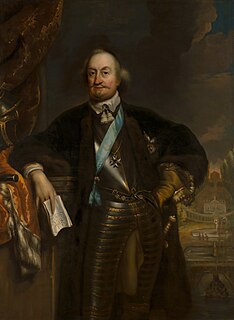
John Maurice of Nassau was called "the Brazilian" for his fruitful period as governor of Dutch Brazil. He was Count and Prince of Nassau-Siegen, and Grand Master of the Order of Saint John.

The Binnenhof is a complex of buildings in the city centre of The Hague, Netherlands, next to the Hofvijver. It houses the meeting place of both houses of the States General of the Netherlands, as well as the Ministry of General Affairs and the office of the Prime Minister of the Netherlands. Built primarily in the 13th century, the Gothic castle originally functioned as residence of the counts of Holland and became the political centre of the Dutch Republic in 1584. It is counted among the Top 100 Dutch heritage sites. The Binnenhof is among the oldest Parliament buildings in the world still in use.
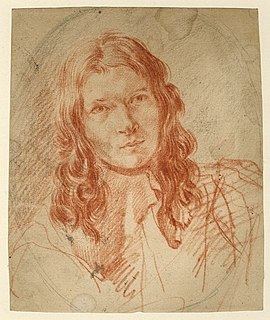
Philips Wouwerman was a Dutch painter of hunting, landscape and battle scenes.
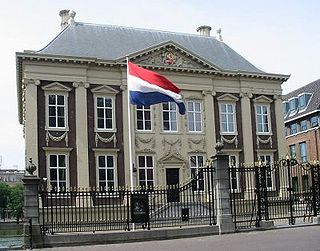
Jacob van Campen, was a Dutch artist and architect of the Golden Age.

Michiel Janszoon van Mierevelt, often abbreviated as Michiel Jansz. and the surname also spelled Miereveld or Miereveldt, was a Dutch painter and draftsman of the Dutch Golden Age.
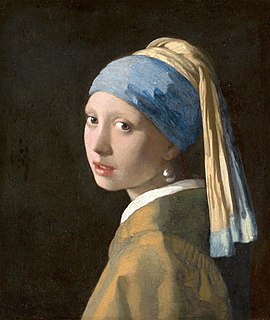
Girl with a Pearl Earring is an oil painting by Dutch Golden Age painter Johannes Vermeer, dated c. 1665. Going by various names over the centuries, it became known by its present title towards the end of the 20th century after the earring worn by the girl portrayed there. The work has been in the collection of the Mauritshuis in The Hague since 1902 and has been the subject of various literary and cinematic treatments.

The Bargate is a Grade I listed medieval gatehouse in the city centre of Southampton, England. Constructed in Norman times as part of the Southampton town walls, it was the main gateway to the city. The building is a scheduled monument, which has served as a temporary exhibition and event space for Southampton Solent University since 2012.

Adriaen Hanneman was a Dutch Golden Age painter best known for his portraits of the exiled British royal court. His style was strongly influenced by his contemporary, Anthony van Dyck.
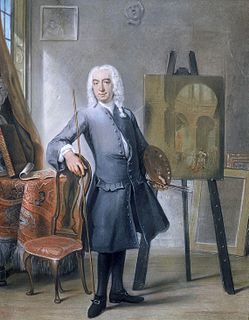
Cornelis Troost was an 18th-century actor and painter from Amsterdam.
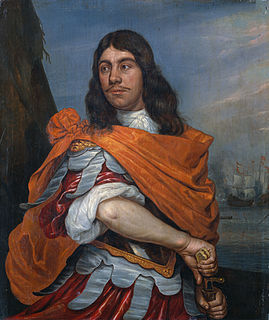
In the history of the Dutch Republic, Orangism or prinsgezindheid was a political force opposing the Staatsgezinde (pro-Republic) party. Orangists supported the Princes of Orange as Stadtholders and military commanders of the Republic, as a check on the power of the regenten. The Orangist party drew its adherents largely from traditionalists – mostly farmers, soldiers, noblemen and orthodox Catholic and Protestant preachers, though its support fluctuated heavily over the course of the Republic's history and there were never clear-cut socioeconomic divisions.

The Hofvijver is an artificial lake in the centre of The Hague, Netherlands. It is adjoined in the east by the Korte Vijverberg (road), in the south by the Binnenhof and the Mauritshuis, in the west by the Buitenhof and in the north by the Lange Vijverberg (road). In the middle there is a small island with plants and trees which has no name, it is usually referred to as "the island in the Vijverberg".

Jacobus Ludovicus Cornet, also known by his initials as J.L. Cornet, was a Dutch painter and draughtsman. He often depicted Dutch historic scenes and figures, contributing several paintings to Jacob de Vos Jacobszoon's gallery of oil paintings depicting scenes from Dutch history. Cornet also painted and drew portraits, landscapes, interiors and a range of other subjects.

The Torentje, located at the Binnenhof in The Hague next to the Mauritshuis museum, has been the official office of the Prime Minister of the Netherlands since 1982.

The Buitenhof is a square in The Hague, Netherlands, adjacent to the Binnenhof and the Hofvijver pond. It is listed in the Top 100 Dutch heritage sites.

The Young Bull or The Bull is an oil painting of a bull by Paulus Potter. It is in the collection of the Mauritshuis in The Hague in the Netherlands.

The Threatened Swan is an oil painting of a mute swan made around 1650 by Dutch Golden Age painter Jan Asselijn. The work is in the collection of the Rijksmuseum in Amsterdam in the Netherlands.

The Prince William V Gallery is an art gallery on the Buitenhof in The Hague that currently shares an entrance with the Gevangenpoort museum. It is a recreation of the original gallery Galerij Prins Willem V, once founded there by William V, Prince of Orange in 1774. The displayed paintings are part of the collection of the Mauritshuis. Amongst the paintings on display are works by Peter Paul Rubens, Jan Steen, Paulus Potter and Gerard van Honthorst.

The Corpses of the De Witt Brothers is a c. 1672–75 oil on canvas painting by the Dutch Golden Age painter Jan de Baen, now in the Rijksmuseum in Amsterdam. It shows the dead and mutilated bodies of the brothers Johan and Cornelis de Witt hanging upside down on the Groene Zoodje, the place of execution in front of the Gevangenpoort in The Hague.




























